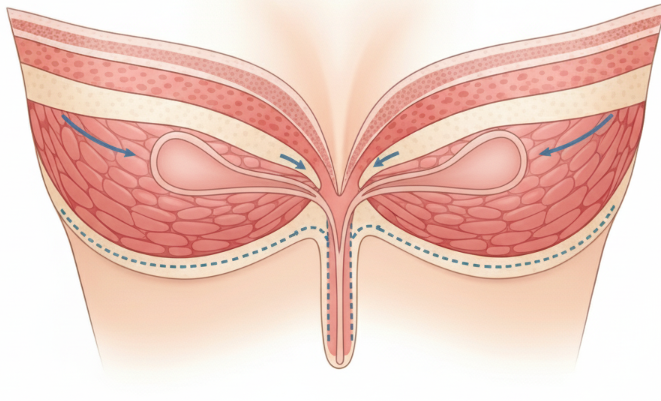Treatment Overview
Inverted-T Top Surgery (also known as Anchor Incision Mastectomy) is a gender-affirming chest masculinization procedure designed for patients with very large chests, significant ptosis (sagging), or poor skin elasticity. Unlike the standard double-incision, this technique combines horizontal and vertical incisions in an anchor-like pattern, allowing surgeons to remove excess tissue, skin, and fat, while reshaping the chest into a flatter, more masculine contour.
In Korea, plastic surgeons are recognized for their precision in complex chest surgeries and for using scar-minimizing techniques, 3D planning, and advanced aftercare programs. This makes Korea a popular destination for individuals seeking safe, affordable, and aesthetically refined top surgery results.
Purpose & Benefits
- Chest Masculinization: Achieves a flat, masculine chest for patients with larger breast sizes.
- Enhanced Skin Removal: Ideal for individuals with significant sagging or low elasticity.
- Nipple Resizing & Repositioning: Nipples are often resized and repositioned for symmetry.
- Improved Chest Contour: Addresses excess skin and fat not correctable by other top surgery methods.
- Permanent Results: Breast tissue is permanently removed.
- Life-Changing Impact: Enhances gender affirmation and boosts confidence.
Ideal Candidates
- Trans men, non-binary, and gender-diverse patients with very large chest sizes (D+ cup).
- Individuals with significant skin laxity, often due to weight loss or aging.
- Patients unsuitable for keyhole, peri-areolar, or standard double-incision techniques.
- Adults in good health and stable weight.
- Non-smokers with realistic expectations regarding longer scarring.
Possible Risks & Complications
- Visible anchor-shaped scars (fade but remain permanent).
- Temporary swelling, bruising, or tightness.
- Nipple complications (partial graft loss, changes in sensation).
- Asymmetry or contour irregularities.
- Rare risks: infection, hematoma, delayed wound healing.
Techniques Used
- Anchor / Inverted-T Incision: Combines horizontal incisions across the chest with vertical incisions down from the areola.
- Free Nipple Graft (FNG): Nipples are removed, resized, and grafted into a masculine position.
- Liposuction (Optional): May be used for side chest and underarm contouring.
- Scar-Minimizing Suturing: Multi-layer closure, medical adhesives, and scar-care treatments to reduce scar thickness.
Recovery & Aftercare
- 1–2 weeks: Swelling and bruising peak, then improve.
- 2–3 weeks: Return to desk work and light daily activities.
- 4–6 weeks: Resume light exercise; avoid chest-intensive workouts.
- 3–6 months: Chest contour refines and scars begin to fade.
Aftercare Guidelines:
- Wear a compression garment for 4–6 weeks to reduce swelling.
- Follow scar-care protocols (silicone sheets, scar creams, laser if recommended).
- Protect scars from sun exposure to avoid darkening.
- Avoid smoking and alcohol to support healing.
- Attend follow-ups for wound checks and contour assessment.
Results & Longevity
- Flat, masculine chest contour even for very large chest sizes.
- Permanent removal of breast tissue.
- Repositioned and resized nipples for natural appearance.
- Anchor-shaped scarring (typically fades but remains visible).
- Permanent results that significantly improve gender affirmation and body confidence.
Treatment Process in Korea
1. Consultation & Planning
- Surgeons assess chest size, skin elasticity, and patient goals.
- 3D simulations may be used to visualize outcomes.
- Surgical plan designed with incision mapping and nipple graft placement.
2. Surgery Day
- Performed under general anesthesia.
- Inverted-T incisions made to remove tissue and excess skin.
- Nipples resized and repositioned with free nipple grafts.
- Drains may be placed to prevent fluid buildup.
3. Post-Operative Monitoring
- Compression vest applied immediately.
- Hospital stay typically 1 night, depending on extent of surgery.
4. Follow-Up & Refinement
- Follow-ups at 1 week, 1 month, and 3–6 months.
- Scar-care programs and minor revisions offered if needed.
Why Korea is a Top Destination
- Surgeons experienced in complex chest masculinization surgeries.
- Access to advanced scar management (lasers, silicone therapy, microneedling).
- Affordable pricing compared to the US and Europe.
- Discreet, LGBTQ+ friendly clinics with multilingual staff.
- Comprehensive recovery programs for international patients.
Cost Range
The cost of Inverted-T Top Surgery in Korea depends on the clinic, surgeon’s expertise, and complexity.
Estimated Pricing:
- Standard Inverted-T Top Surgery: USD $9,500 – $13,000
- With Free Nipple Graft: USD $10,000 – $14,500
- With Liposuction Refinement: USD $11,000 – $15,500
- Premium Clinics (scar-care + VIP aftercare): USD $13,000 – $18,000
Additional Costs:
- Consultation & pre-op testing: USD $200 – $500
- Compression vests: USD $150 – $300
- Scar management programs: USD $300 – $800
- Medications & aftercare: USD $200 – $400
Popular Clinics
- Banobagi Plastic Surgery (Seoul): Experts in complex top surgeries for larger chests.
- ID Hospital (Seoul): Known for advanced chest masculinization with aesthetic nipple grafts.
- JK Plastic Surgery Center (Seoul): JCI-accredited, premium aftercare for international patients.
- View Plastic Surgery Clinic (Seoul): Specialists in anchor-incision top surgeries and scar refinement.
- JW Plastic Surgery (Seoul): Experienced in high-volume top surgeries with natural masculine contouring.




